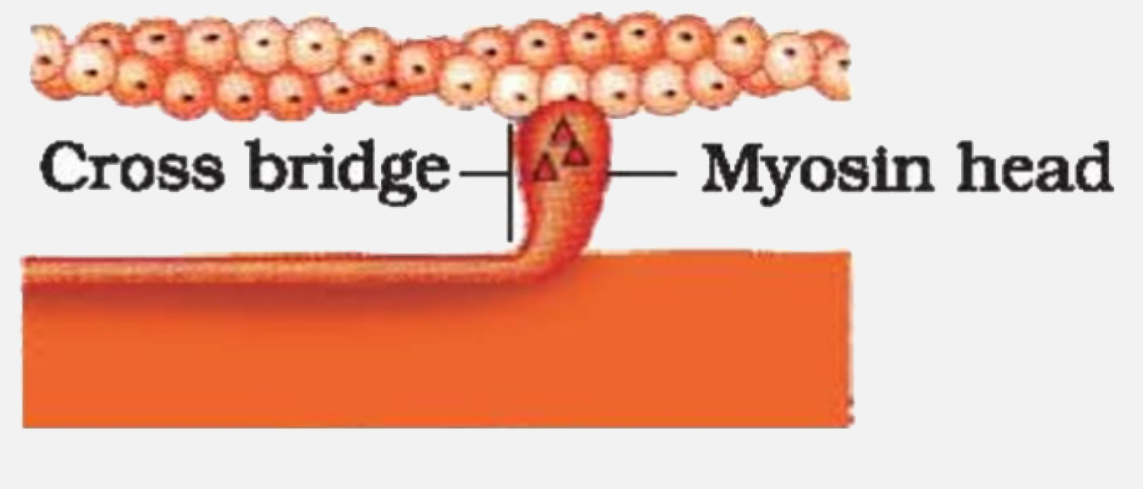The cross bridges are present on the:
Z line
actin filament
myosin filament
sarcolemma
To solve the question regarding where the cross bridges are present, we can follow these steps:
1. Understand the Structure of Sarcomeres:
- Sarcomeres are the basic contractile units of muscle fibers. They are composed of thick and thin filaments.
2. Identify the Components:
- The thick filaments are primarily made up of myosin, while the thin filaments consist mainly of actin.
3. Examine the Myosin Filaments:
- Myosin filaments have a specific structure where each myosin molecule resembles a golf club. The head of the myosin molecule extends outward.
4. Define Cross Bridges:
- Cross bridges are formed when the head of the myosin filament binds to the actin filament during muscle contraction. This interaction is crucial for muscle movement.
5. Analyze the Options:
- Option 1: Z line - This is where the actin filaments are anchored but does not contain cross bridges.
- Option 2: Actin filament - While it interacts with myosin, the cross bridges are not present on the actin itself.
- Option 3: Myosin filament - This is where the cross bridges are located, specifically on the heads of the myosin molecules.
- Option 4: Sarcolemma - This is the membrane surrounding muscle fibers and does not contain cross bridges.
6. Conclusion:
- The correct answer is myosin filament, as the cross bridges are present on the heads of the myosin proteins.
Final Answer:
The cross bridges are present on the myosin filament.
---
- Sarcomeres are the basic contractile units of muscle fibers. They are composed of thick and thin filaments.
- The thick filaments are primarily made up of myosin, while the thin filaments consist mainly of actin.
- Myosin filaments have a specific structure where each myosin molecule resembles a golf club. The head of the myosin molecule extends outward.
- Cross bridges are formed when the head of the myosin filament binds to the actin filament during muscle contraction. This interaction is crucial for muscle movement.
- Option 1: Z line - This is where the actin filaments are anchored but does not contain cross bridges.
- Option 2: Actin filament - While it interacts with myosin, the cross bridges are not present on the actin itself.
- Option 3: Myosin filament - This is where the cross bridges are located, specifically on the heads of the myosin molecules.
- Option 4: Sarcolemma - This is the membrane surrounding muscle fibers and does not contain cross bridges.
- The correct answer is myosin filament, as the cross bridges are present on the heads of the myosin proteins.
The cross bridges are present on the myosin filament.
Topper's Solved these Questions
- BOOK - ICSECHAPTER - LOCOMOTION AND MOVEMENTEXERCISE - REVIEW QUESTIONS (FILL IN THE BLANKS)18videos
LOCOMOTION AND MOVEMENT
- BOOK - ICSECHAPTER - LOCOMOTION AND MOVEMENTEXERCISE - REVIEW QUESTIONS (MARK THE ODD ONE OUT)4videos
LOCOMOTION AND MOVEMENT
- BOOK - ICSECHAPTER - KINGDOM PROTISTAEXERCISE - REVIEW QUESTIONS (VI Long answer type questions)5videos
KINGDOM PROTISTA
- BOOK - ICSECHAPTER - LOCOMOTIONA ND MOVEMENT EXERCISE - NCERT EXERCISES WITH ANSWER (DIFFERENTIATE BETWEEN)8videos
LOCOMOTIONA ND MOVEMENT
Similar Questions
Where are cross bridges present?
View SolutionA salt bridge
View SolutionWhich of the following stage of cross-bridge is shown in the diagram?
 View Solution
View SolutionA: When soldier cross a bridge, they are asked to break steps.
R: If they do not break steps, then they will apply large force on bridge simutaneously.View SolutionStatement-1: The bridges are declared unsafe after a long use.
Statement-2: Elastic strength of bridges losses with time.View SolutionTest cross is a cross between
View SolutionCross bridges of sarcomere in skeletal muscle are made up of
View SolutionCytoplasmic bridges present between adjacent cells.
View SolutionWhich of the following events leads to the breakdown cross-bridges during muscle contraction?
View SolutionAssertion: soldiers are asked to break steps while crossing the bridge.
Reason: The frequency of marching may be equal to the natural frequency of bridge and may lead to resonance which can break the bridge.View Solution

